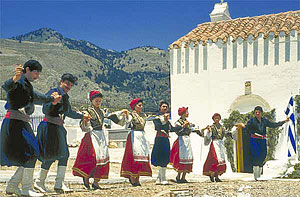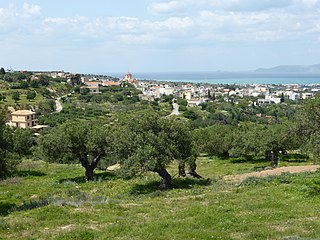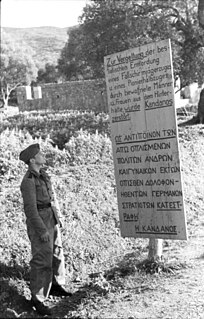
Crete is the largest and most populous of the Greek islands, the 88th largest island in the world and the fifth largest island in the Mediterranean Sea, after Sicily, Sardinia, Cyprus and Corsica. It bounds the southern border of the Aegean Sea. Crete rests approximately 160 km (99 mi) south of the Greek mainland. It has an area of 8,336 km2 (3,219 sq mi) and a coastline of 1,046 km (650 mi).

Chania is the second largest city of Crete and the capital of the Chania regional unit. It lies along the north coast of the island, about 70 km (43 mi) west of Rethymno and 145 km (90 mi) west of Heraklion.

Greek art began in the Cycladic and Minoan civilization, and gave birth to Western classical art in the subsequent Geometric, Archaic and Classical periods. It absorbed influences of Eastern civilizations, of Roman art and its patrons, and the new religion of Orthodox Christianity in the Byzantine era and absorbed Italian and European ideas during the period of Romanticism, until the Modernist and Postmodernist. Greek art is mainly five forms: architecture, sculpture, painting, pottery and jewelry making.

The Sfakians are the inhabitants of the region of Sfakia located in western Crete. The Sfakians hold themselves to be the direct descendants of the Dorians who invaded the island around 1100 BC.

Gouves is a village and former municipality in the Heraklion regional unit, Crete, Greece. Since the 2011, local government reform it is part of the municipality Hersonissos, of which it is a municipal unit. The municipal unit has an area of 94.963 km2 (36.665 sq mi). It lies around 20 km (12 mi) east of Heraklion.

Arkalochori is a town and a former municipality in the Heraklion regional unit, Crete, Greece. Since the 2011 local government reform it is part of the municipality Minoa Pediada, of which it is a municipal unit. The municipal unit has an area of 237.589 km2 (91.734 sq mi).

Mustafa Naili Pasha was an Ottoman statesman, who held the office of Grand Vizier twice during the reign of Abdülmecid I, the first time between 14 May 1853 and 29 May 1854, and the second time between 6 August 1857 and 22 October 1857.

Koufonisi is an uninhabited Greek islet, located 3 nautical miles south of cape Goudero on the coast of Lasithi, eastern Crete, in the Libyan Sea. The island is roughly 6 kilometres long and 5.5 kilometres across. It has an entire surface area of 5.25 square kilometres (2.03 sq mi). It forms a close group of islands with Makroulo, Marmaro, Strongyli, and Trachilos.

The Lasithi Plateau, sometimes spelt Lassithi Plateau is a high endorheic plateau, located in the Lasithi regional unit in eastern Crete, Greece. Since the 1997 Kapodistrias reform, it is a municipality whose seat is Tzermiado and the second biggest village is Agios Georgios. The municipality has an area of 129,9 km2.

The Cretan resistance was a resistance movement against the occupying forces of Nazi Germany and Italy by the residents of the Greek island of Crete during World War II. Part of the larger Greek Resistance, it lasted from 20 May 1941, when the German Wehrmacht invaded the island in the Battle of Crete, until the spring of 1945 when they surrendered to the British. For the first time during World War II, attacking German forces faced in Crete a substantial resistance from the local population. Cretan civilians picked off paratroopers or attacked them with knives, axes, scythes or even bare hands. As a result, many casualties were inflicted upon the invading German paratroopers during the battle.

Frangokastello is the location of a castle and scattered settlement on the south coast of Crete, Greece, about 12 km east of Chora Sfakion and within the prefecture of Chania.

The Cretan revolt of 1866–1869 or Great Cretan Revolution was a three-year uprising in Crete against Ottoman rule, the third and largest in a series of Cretan revolts between the end of the Greek War of Independence in 1830 and the establishment of the independent Cretan State in 1898.

The Kallergis family is a Cretan aristocratic family said to be descended from Byzantine Emperor Nikephoros II Phokas, and were at one stage the mightiest noblemen of Crete.

The Realm or Kingdom of Candia or Duchy of Candia was the official name of Crete during the island's period as an overseas colony of the Republic of Venice, from the initial Venetian conquest in 1205–1212 to its fall to the Ottoman Empire during the Cretan War (1645–1669). The island was at the time and up to the early modern era commonly known as Candia after its capital, Candia or Chandax. In modern Greek historiography, the period is known as the Venetocracy.
Atmeydanı incident was an uprising which occurred at the Hippodrome of Constantinople in Istanbul, the capital of the Ottoman Empire, in 1648.
Ismail Selim Pasha, also known as Ismail Ferik Pasha, was an Egyptian general of Greek origin. He was a son of the priest Fragios Kampanis Papadakis.
Melchisedek Tsouderos was a Greek monk and fighter of the Greek War of Independence from Crete. He was killed in 1823 in a battle against the Ottoman forces.
Alexios Alexis (1692-1786) was a soldier from Lassithi Plateau on the island of Crete. He played a major role in the Cretan wars for independence. His father was the nobleman Misser Alexis. Alexios led a large and eminent family and some of his descendants reached high ranks in Greece and abroad, including Nicholas Alexios Alexis, and the Army General Ioannis Sotiris Alexakis.
Ioannis Sotiris Alexakis (1885–1980) was a Cretan lieutenant general. He fought in both Balkan Wars, in World War I, the Asia Minor Campaign and World War II. He fought in numerous battles and was decorated with 20 medals for bravery.
The Conspiracy of Sifis Vlastos was a fifteenth-century planned rebellion against the Republic of Venice in the overseas colony of Crete, named after its chief instigator. Vlastos and his collaborators were betrayed to the Venetian authorities, who swiftly arrested and executed them in 1454. A smaller, follow-on plan for an intended uprising against Venice was dismantled in 1462.